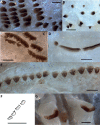The Nereididae (Annelida) - diagnoses, descriptions, and a key to the genera
- PMID: 37868122
- PMCID: PMC10585372
- DOI: 10.3897/zookeys.1182.104258
The Nereididae (Annelida) - diagnoses, descriptions, and a key to the genera
Abstract
Nereididae is among the most familiar of marine annelid families, common and well-studied in most marine environments but paradoxically no recent key or identification guide exists to the world's genera. Here updated generic descriptions, a list of characters, a linear key to genera, and minimal diagnoses that distinguish each genus from all others in the family are provided. This information is generated from a Delta database of 186 morphological characters and a link is provided to downloadable software allowing the same data to be interrogated using the open-source Delta program Intkey - a nonlinear multiple entry point computerised interactive key. For each genus the recent literature is also summarised, comments on taxonomic status provided, and published keys to species cited. Nexus format matrices are provided for all 45 genera and 158 Nereididae species, representing all genera, scored for 146 multistate characters from the same character list to facilitate future phylogenetic studies.
Keywords: Computer taxonomy; Taxonomic Information System; diagnosis; identification tools; natural language descriptions; polychaete; taxonomic verification.
Robin S. Wilson, Christopher J. Glasby, Torkild Bakken.
Conflict of interest statement
The authors have declared that no competing interests exist.
Figures




References
-
- Alves PR, Halanych KM, Santos CSG. (2020) The phylogeny of Nereididae (Annelida) based on mitochondrial genomes. Zoologica Scripta 49(3): 366–378. 10.1111/zsc.12413 - DOI
-
- Alves PR, Halanych KM, Silva EP, Santos CSG. (2023) Nereididae (Annelida) phylogeny based on molecular data. Organisms, Diversity & Evolution 23(3): 529–541. 10.1007/s13127-023-00608-9 - DOI
-
- Atlas of Living Australia (2014) Open-delta. A Java port of the Delta – Description Language for Taxonomy suite of applications into Java. Canberra, Australia. https://github.com/AtlasOfLivingAustralia/open-delta [Accessed 29 April 2014]
Publication types
LinkOut - more resources
Full Text Sources
